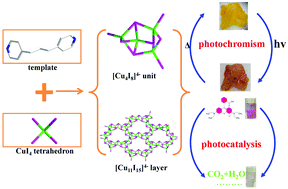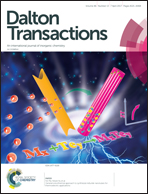Di-pyridyl organic cation directed hybrid cuprous halogenides: syntheses, crystal structures and photochromism and photocatalysis†
Abstract
By using 1,3-di(4-pyridyl)-propane (dpp) as templates or structure-directing agents (SDAs), a series of hybrid cuprous halogenides, namely, [H2dpp]2[Cu4I8]·H2O (1), [H2dpp][Cu2I4] (2), [H2dpp]2Cu11I15 (3) and [H2dpp]2Cu11Br15 (4), have been solvothermally prepared and structurally characterized. Despite the similar chemical compositions, compound 1 features a zero-dimensional (0D) [Cu4I8]4− unit and compound 2 contains one-dimensional (1D) [Cu2I4]2− chains, which are both separated by [H2dpp]2+ organic cations. Compounds 3–4 contain two-dimensional (2D) microporous [Cu11X15]4− (X = I, Br) layers composed of the [Cu9X17] unit interconnected by [CuX4] tetrahedra. The UV-vis diffuse-reflectance measurements reveal that the compounds 3–4 exhibit semiconducting behaviors with narrow band gaps of 1.48 and 2.21 eV, respectively, which lead to efficient photocatalytic degradation activities over an organic pollutant under visible light irradiation. The possible photocatalytic mechanism is also proposed based on experimental and theoretical studies. Furthermore, compound 1 shows interesting photochromism behavior maybe owing to the photo-induced intermolecular charge transfer.



 Please wait while we load your content...
Please wait while we load your content...